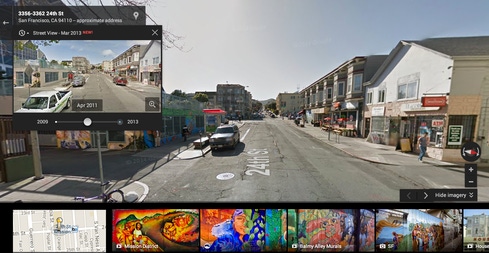Google Street View Offers Time TravelGoogle Street View Offers Time Travel
Street View images from different periods can now be compared to see how places have changed over time.


Google's 10 Big Bets On The Future
Google's 10 Big Bets On The Future (Click image for larger view and slideshow.)
Google Maps Street View gained a new feature on Wednesday: a way to travel through time.
Street View has always offered time travel of a sort: Its images show the past. But now Street View can display multiple pictures of a place taken over a span of years.
"Starting today, you can travel to the past to see how a place has changed over the years by exploring Street View imagery in Google Maps for desktop," said Vinay Shet, Google Street View product manager, in a blog post. "We've gathered historical imagery from past Street View collections dating back to 2007 to create this digital time capsule of the world."
If you could actually travel to the past, your view of Street View would be different. Were you to travel back to 2007, for example, you might watch a Google Street View car drive past, unaware that it was capturing private data from open WiFi access points.
[Google plans to use drones to bring the Internet to remote locations. Read Google Has Plans For Titan Drones.]
A visit to 2008 would take you a time when the US Defense Department banned Street View cars from military bases as a matter of operational safety. Photography during this period was often assumed by authorities to be a precursor to terrorism. That was the year London's Metropolitan Police launched a counter-terrorism campaign warning citizens to watch for "odd" photographers. It was also the year Google began testing a way to blur the faces of people in Street View images.
In 2009, you might find Google scrambling to correct sensationalistic claims that its Street View cars had photographed a naked toddler, or wondering why the residents in the Buckinghamshire village of Broughton in the UK refused to allow a Street View car to enter town.
That same year, in Greece and Switzerland, Street View cars were briefly banned until Google could reassure officials that adequate privacy protections were in place. And Google had to reshoot some of its Street View imagery in Japan because the roof-mounted cameras on its cars could see into people's backyards.
But as you move closer to the present, the controversies diminish. You'd see Google settling the Street View privacy litigation. You'd see the world grow weary of fighting for privacy rights that governments ignore while telling others to observe. You'd see people getting over their fears and realizing just how useful Street View can be.
Street View's temporal scope is limited by the number of Street View car visits since the service launched, which in many cases is only two or three. Even so, the ability to access a time-lapse view of a place can be useful from a historical perspective. If you travel back in time from the 2013 default Street View image of this street in San Francisco to the image taken in April 2011, you can see how things looked before a mural was added to the wall on the left.
Just imagine how interesting Street View time travel will be after a few more decades of data.
Mobile, cloud, and BYOD blur the lines between work and home, forcing IT to envision a new identity and access management strategy. Also in the The Future Of Identity issue of information: Threats to smart grids are far worse than generally believed, but tools and resources are available to protect them. (Free registration required.)
About the Author
You May Also Like






